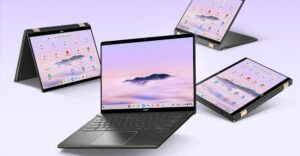
Two of my favorite attractions at Disneyland when I was growing up and working at the park, and which are no longer there, were the Carousel of Progress and the House of the Future.
Both showcased a future based on the thinking that was going on when I was born. They did this by creating models, miniatures of cities and full-sized representations of the home, rooms, and appliances inside them. The Carousel of Progress started with the past and moved to the future, while the House of the Future existed in a future that almost came to pass.
Many of the things imagined — like cook tops, robotic vacuums (Roomba), and built-in refrigerators — actually came to pass. Some — like fiberglass houses (which could survive earthquakes, tornadoes, and floods) and monorails (with some exceptions) — didn’t. I’ve ridden a number of the monorails and recently rode the Maglev train in China and have watched a number of disasters destroy homes that would have likely survived had they been built like the House of the Future.
I was around when they tore down the House of the Future; the massive wrecking ball hit the thing again and again and bounced off the house. They eventually had to cut it up.
I think one of the reasons we haven’t seen these advancements is because it was too expensive to model and test these systems and to collaborate with experts around the world to make them possible. I know the monorail linking Orange County, Calif., to Los Angeles International Airport, which was to initially cost US$3 million, was killed after $9 million was spent to showcase how it wouldn’t have been profitable.
A good simulation might have reversed that decision, and it will always amaze me that in those days it was less expensive to build something than to model it. It is kind of sad that Iran and other countries may move to this technology long before we do.
I think that the combination of visual computing that Nvidia talks about and visual networking that Cisco talks about could make amazing things like Walt Disney imagined become real. Let’s talk about that this week.
In addition, we’ll have my product of the week — the most exciting PC case I’ve seen in years.
The Power of Imagination Made Real
I was at Nvision last week, which is Nvidia’s vastly more fun version of IDF, the focus of my column last week.
What makes it more fun is the huge focus on gaming and simulation. Here you can let your imagination run free and see things that used to only exist in folks’ heads and sometimes on canvas. Here these things not only look real, in many cases they are prototypes of products that will eventually be sold in the real world.
One of the fascinating demonstrations was using a game engine to create a movie, and the overall production quality — while not up to Pixar or Dreamworks standards — was actually close enough to be very watchable.
In walking the floor of the event, I found tools being used to create 3-D environments that could be viewed using special glasses or special monitors. These were side by side with demonstrations of products that allowed you to interact with these 3-D objects by using simple hand gestures or special controllers. All of them were designed to be sold in price ranges that could be acceptable to general consumers.
It created the promise of real-time movies and TV shows that people could create dynamically. Richer online games are coming closer to bridging the gap between the games of today and the Holodeck many of us came to lust for in “Star Trek: The Next Generation.”
Even the demonstrations on how you could overcome the modeling costs associated with the things I started with that were imagined at Disney to eventually allow a home inventor to better dream up and create the next big hit gadget were evident on the show floor.
Unfortunately for me, this was another expensive event, as it showcased the new Audis and I fell helplessly in love with one, which I guess means I’m buying a new car with a really cool navigation and entertainment system next year.
But this show is only part of the story I was thinking about this week, because once I dovetailed it with what Cisco has been talking about, I saw an even bigger picture.
Visual Networking: Going to Hyperspeed
Yes, you could create amazing things, but without the bandwidth to share these things with others, the movies, games, designs and ideas wouldn’t get where they need to go to find manufacturing, viewers or markets to consume them. This is where visual networking came in and my meeting with Cisco last week where I got an overview of the amazing things that transformed NBC for the Olympics and the Democratic National Convention.
NBC used to rely on moving tapes physically from location to location and having to put the tapes through editing before they could be substantially enhanced. We can all remember how they used to showcase sports moves using a pointer. Now coupled with the kind of tools Nvidia was showcasing, they can real-time edit, bypass the tapes and deliver rich content in real time. At the Nvision event, Nvidia showcased how NASCAR race commentators actually visually represent drafting on real-time races thanks to a combination of visual computing and visual networking.
Now, if we extrapolate the high-bandwidth network and the creative capability being showcased by both firms, we have the very real opportunity to create massive real time collaborative networks where creative people can build amazing things from all over the globe.
You could pull together designers from Asian, Italian, and U.S. design centers and build a virtual prototype car in hours instead of months or years and have it into production in months instead of years. It even provides for the potential of having final assembly distributed to cut down on the massive shipping costs currently creating a drag on a number of industries. And finally, how about the very real possibility that you could design and have built at some future point a car, appliance, device, or article of clothing that was uniquely yours?
You couple visual computing and visual networking with a cloud-based set of applications and services, and amazing things will happen. I think we are at the beginning of a time when our imaginations will define much of our lives. Let’s hope those imaginations are a little closer to Disney and some distance from War of the Worlds.
Product of the Week: Antec Skeleton Computer Case
As some of you know, one of my hobbies is building PCs, but the cases tend to be different sized boxes where the creativity is in the trim and the cool parts often get in the way of the assembly and use. Well, Antec will be selling my dream case shortly, and they had it at Nvision. Called the “Antec Skeleton Case,” this thing is wild — check out the picture.
A massive fan sits cantilevered over the base, all of which is wide open and allows the quick swap out of any major component — from motherboard to graphics cards and power supply. You can find a more detailed overview of the prototype here.
For those who like to constantly upgrade their PC to the newest stuff quickly, this is case is a dream. Granted, I’m already thinking of how to custom paint the thing, and it isn’t shielded at all so you wouldn’t want this around medical equipment, pets or small children — but I am so looking forward to picking one of these up.
It won’t show up for a couple of weeks, and I’m guessing it will cost under $150. Because this makes something I love to do better, because it looks frickin’ wild, and because it showcases incredible imagination, the Antec Skeleton Computer Case is my product of the week.
Rob Enderle is a TechNewsWorld columnist and the principal analyst for the Enderle Group, a consultancy that focuses on personal technology products and trends.



















































